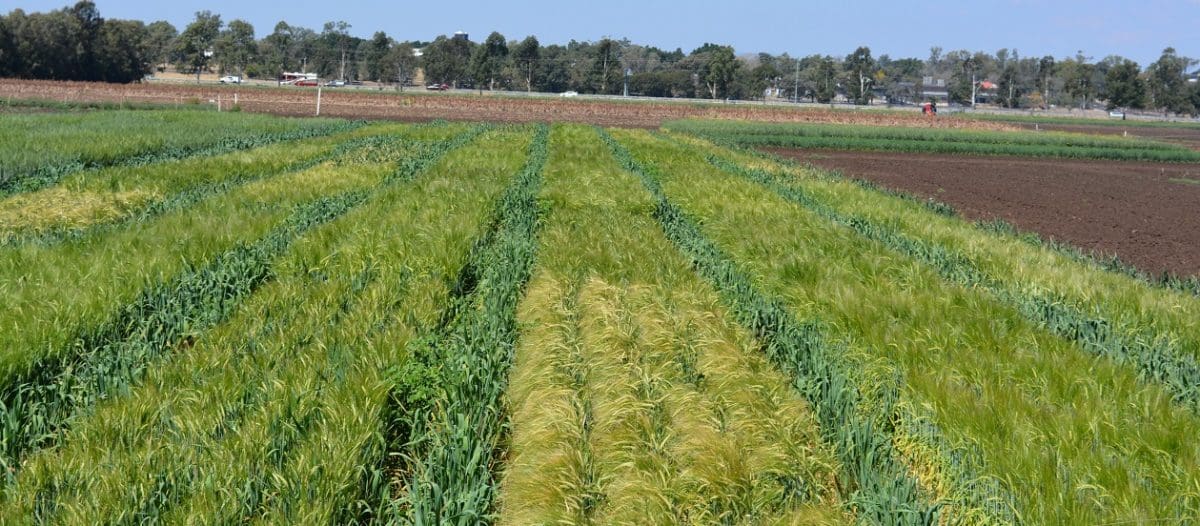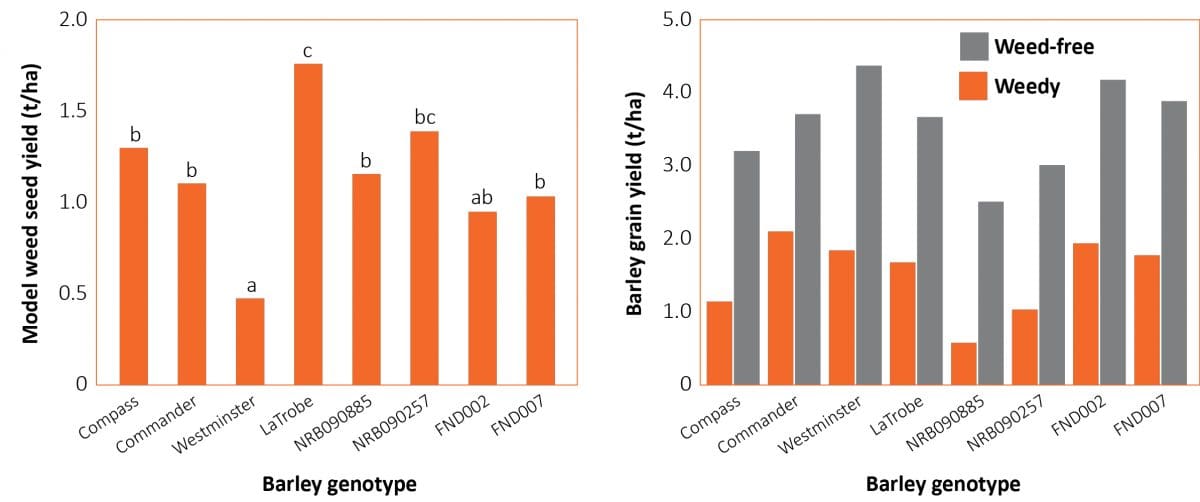
QAAFI weed science and plant breeding researchers conducted a two-year field trial at Gatton, Queensland, to investigate the varying levels of weed competitive ability in eight barley genotypes.
BARLEY is known as a fairly competitive crop, but not all genotypes are equal when it comes to weed suppression and weed tolerance.
To unpick the complex mechanisms behind competitive ability in barley, Queensland Alliance for Agriculture and Food Innovation (QAAFI) weed researchers Gulshan Mahajan and Bhagirath Chauhan and cereal plant breeder Lee Hickey teamed up to quantify the effect of weed interference on commercial and elite-line barley genotypes.
Their two-year field trial compared the competitive ability of eight barley genotypes against a mimic weed (oats) by measuring weed biomass, weed seed production and barley yield.
Practical tips:
- Weeds can cause huge yield losses in barley – between 43 and 78 per cent difference between weedy and weed-free growing conditions for the eight genotypes tested.
- There is considerable variation in the weed competitive ability of current and elite breeding lines of barley in Australia.
- The most weed suppressive variety, Westminster, reduced weed seed production by 73pc, compared with that of LaTrobe. Similarly, weed biomass of Westminster reduced by 55pc, compared with that of LaTrobe.
- There is scope for the development of high-yielding weed-competitive barley genotypes through additional screening of elite lines in weedy conditions.
- Higher panicle production in barley appears to be a strong indicator of a genotype’s competitive ability.
- When it comes to using a crop to compete with weeds there are two discreet mechanisms – 1. weed suppression, where the growth and seed production of weed plants is reduced and 2. weed tolerance, where crop yield is maintained, even in weedy conditions.
The most competitive genotypes will use both of these mechanisms and knowing which mechanisms are at play is valuable information when planning an integrated weed control program.
Competitive genotypes are a powerful non-herbicide weed control tactic and growers will gain significant benefits if they can plant a strong weed-suppressive crop into a weedy situation, particularly if they do not have to sacrifice yield.
While yield and malt quality have driven the barley breeding program to date in Australia, this research suggests that there is great advantage in understanding the response of the variety to weed pressure.
Observations on the competitive ability of the four commercial varieties tested:
- Commander barley is both weed suppressive and weed tolerant. If sown with an effective pre-emergent herbicide, Commander is probably the best choice to maintain low weed numbers.
- Westminster is the most weed suppressive and might be a better choice if weed numbers are starting to increase, or for use in low input and organic production systems. Westminster is not weed tolerant, so a significant yield penalty should be expected in weedy situations.
- Although Compass is tall and has a droopy architecture (like Commander and Westminster) it is not weed suppressive or weed tolerant, and should only be chosen for weed-free situations.
- LaTrobe is the least weed seed suppressive but is weed tolerant, maintaining a reasonable yield in the presence of weeds.
- The competitive ability of a particular genotype may vary in different locations, seasons and management systems, and in the presence of different weed species.

Figure 1: Left: Weed seed yield in weedy treatment for each barley genotype. Right: Effect of barley genotype and weed treatment on barley grain yield.
Experimental design features
The experiments were conducted in 2017 and 2018 at the University of Queensland research station at Gatton.
The crops were sown at a depth of 5 centimetres in rows 35cm apart on 17 May 2017 and 23 May 2018. The crops were irrigated to maintain field capacity and were harvested on 4 November 2017 and 28 October 2018.
There were eight barley genotypes, weedy and weed-free treatments and three replicates.
Four of the barley genotypes are commercial varieties and four are elite breeding lines being assessed prior to commercial release. Like most other plant breeding programs, Australian barley varieties are usually screened in a weed-free environment with a focus on yield and malting qualities.
In this experiment, each genotype was sown at the recommended seeding rate (125 kg/ha) in a weedy and weed-free environment. Oats was used as a mimic for wild oats, a serious weed in barley. Wild oats could not be used because it has non-uniform germination and sheds its seed before barley harvest.
The plot size was 8 by 1.4 metres. The weedy plots were sown with a commercial oat variety at a target density of 40 plants/m2.
There was no significant seasonal effects so data from the two seasons could be analysed together.
Detailed findings
Weed infestation and genotype influenced the number of panicles produced per metre row length of the barley crop and crop yield. Only genotype influenced crop plant height.
While genotype had a significant impact on weed biomass, weed seed yield, weed-tolerance ability and weed-suppressive ability, phenotypic traits are not always a reliable indicator of a genotype’s weed suppressive ability or weed tolerance ability.
In this experiment, panicle number was a good indicator of both weed suppressive ability and weed tolerance ability, but plant height and architecture were not reliable indicators.
Other factors, such as lodging and harvest index, will also need to be considered in a variety selection process but were not measured in this experiment.
Some genotypes possess both mechanisms for competing successfully with weeds while others possess one but not the other, and some have poor suppression and tolerance.
This research suggests that screening barley varieties in a weedy situation may provide valuable information to growers seeking to choose varieties that will provide the greatest weed suppression and or weed tolerance in weedy paddocks.
It is not possible to screen for competitive ability in a weed-free environment and there is clearly scope for the development of high-yielding weed-competitive barley varieties in Australia.
In the face of increasing herbicide resistance in key weed species, the value of non-herbicide weed control tactics increases considerably.
The real value of crop competition (narrow rows, high seeding rate, weed-competitive genotypes) comes to the fore a few weeks after planting and through the main growing season to suppress late emerging weeds.
Herbicides will remain the main tool for weed control in preparation for planting and to provide a weed-free environment for the crop to establish and rapidly achieve canopy closure.
Source: WeedSmart
This research was conducted and funded by the University of Queensland, a WeedSmart scientific partner.
‘WeedSmart’ is an industry-led initiative that aims to enhance on-farm practices and promote the long term, sustainable use of herbicides in Australian agriculture.

HAVE YOUR SAY